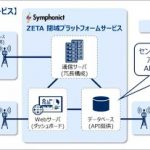
ZiFiSense is the founder of the LPWA standard ZETA, and Techsor is the representative company of the ZETA Alliance in Japan.
The three companies have finalized specifications of the new standard and will conduct demonstration tests aiming for practical uses and its commercialization. Socionext plans to prototype a communication SoC that is compatible with the new standard by March 2022 with mass production scheduled to begin by the end of 2022.
LPWA (Low Power Wide Area) is a wireless communication technology standard suitable for IoT applications. ZETA features bi-directional communication and communication hopping through relays, providing a distinct advantage over other LPWA standards for use in buildings, as well as agricultural and fishing areas where radio waves are difficult to reach.
The newly developed ZETA communication standard is compatible with the new “Advanced M-FSK modulation” and achieves a transfer rate 20 times or more with a sensitivity improvement of 10 dB or more compared with conventional ZETA that uses 2FSK modulation.
The new ZETA version enables a communication distance of 3 ~ 5 km from an object moving at 60 km per hour. Socionext’s unique RF, digital modulation and demodulation technology provides special encoding processing such as error correction and multi-level modulation with low power consumption.
With “Advanced M-FSK modulation”, the modulation method is changed from 2FSK to multi-level modulation such as 64 FSK, and the communication speed improves.
The effect of increased data volume due to error correction and repetition is reduced by the increased transmission speed obtained by multi-level modulation, and the sensitivity can be improved even though the effective transmission speed is the same as the conventional method. This standard is backward compatible and can communicate with existing ZETA equipment.
Existing LPWA solutions have both advantages and disadvantages in terms of speed, sensitivity, and tolerance to mobility, and compounded with various standards, thus making it difficult to select the best solution.
With the addition of a new option that incorporates the Advanced M-FSK modulation to the ZETA standard, new solutions that combine ZETA standards according to the application will become available.
ZETA LPWA networks with optimal characteristics can be built by adjusting the parameters for communication speed, sensitivity, and mobility tolerance according to the application.
Such flexibility makes it possible to apply ZETA to integrate network systems that require a combination of multiple communication methods based on the application types and to simplify and expedite network construction.
Commercialization of the new ZETA standard with these features will further expand the possibilities of LPWA applications, including smart agriculture, smart buildings, and smart logistics.
Socionext plans to prototype a communication SoC compatible with the new standard by March 2022. The three companies will conduct demonstration tests aiming for practical use and commercialization of the new standard and compatible products. Mass production of the communication SoC is scheduled to begin by the end of 2022.
“In developing the next-generation Advanced M-FSK modulation for ZETA, I believe we were able to take full advantage of Socionext’s cutting-edge SoC design technologies and high-performance RF and digital modulation / demodulation technologies,” said Teruaki Hasegawa, Head of the IoT & Radar Sensing Business Unit of Socionext. “We look forward to delivering an SoC with new added value.”